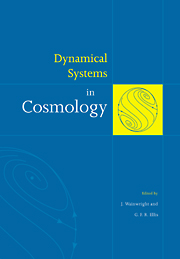Book contents
- Frontmatter
- Contents
- List of contributors
- Preface
- Introduction
- Part one Background
- 1 Geometry of cosmological models
- 2 Friedmann–Lemaître universes
- 3 Cosmological observations
- 4 Introduction to dynamical systems
- Part two Spatially homogeneous cosmologies
- Part three Inhomogeneous cosmologies
- Part four Conclusion
- References
- Subject index
3 - Cosmological observations
Published online by Cambridge University Press: 10 November 2009
- Frontmatter
- Contents
- List of contributors
- Preface
- Introduction
- Part one Background
- 1 Geometry of cosmological models
- 2 Friedmann–Lemaître universes
- 3 Cosmological observations
- 4 Introduction to dynamical systems
- Part two Spatially homogeneous cosmologies
- Part three Inhomogeneous cosmologies
- Part four Conclusion
- References
- Subject index
Summary
The FL universes, based on the RW metric, are the standard models of current cosmology. In this chapter we discuss cosmological observations with a view to assessing the evidence for these models.
There are two stages in this process of assessment:
to discuss to what extent observations require the universe to be close to FL during the different epochs in its evolution,
assuming the universe is close to FL, to discuss the observational constraints on the parameters that characterize an FL universe.
We group the observations that pertain to the first stage under three headings, namely, discrete sources (Section 3.1), the cosmic microwave background radiation (Section 3.2) and the light–element abundances arising from nucleosynthesis in the early universe (Section 3.3). In Section 3.4 we assess the extent to which these observations require the universe to be close to FL in different epochs. We do not discuss events at earlier epochs (e.g. baryogenesis; see Kolb & Turner 1990, Chapter 6) since we regard our current knowledge of the physics concerned as too tentative to lead to reliable constraints. Finally, in Section 3.5 we discuss the ‘best–fit’ FL parameters and the ‘age problem’.
Observations of discrete sources
Observations of discrete sources (primarily galaxies, radio sources, infrared sources and quasars) provide information about the structure of the universe in the galactic epoch (say z ≲ 5).
- Type
- Chapter
- Information
- Dynamical Systems in Cosmology , pp. 65 - 83Publisher: Cambridge University PressPrint publication year: 1997
- 1
- Cited by



